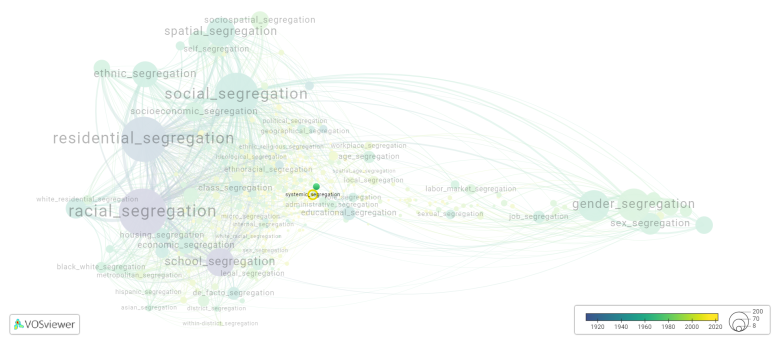Systemic segregation: Difference between revisions
(Creating page) |
(Creating page) |
||
| (One intermediate revision by the same user not shown) | |||
| Line 18: | Line 18: | ||
[[File:systemic_segregation.png|780x780px]] | [[File:systemic_segregation.png|780x780px]] | ||
This visualization is based on the study [[Segregation_Wiki:About| The Multidisciplinary Landscape of Segregation Research]]. | |||
For the complete network of | For the complete network of interrelated segregation forms, please refer to: | ||
* | * [https://tinyurl.com/2235lkhw First year of publication] | ||
* | * [https://tinyurl.com/2d8wg5n3 Louvain clusters] | ||
* | * [https://tinyurl.com/223udk5r Betweenness centrality] | ||
* | * [https://tinyurl.com/244d8unz Disciplines in which segregation forms first emerged (Scopus database).] | ||
==References== | ==References== | ||
==Notes== | ==Notes== | ||
Latest revision as of 07:17, 16 October 2024
Date and country of first publication[1][edit | edit source]
2020
Australia
Definition[edit | edit source]
Systemic segregation refers to a form of segregation that is deeply ingrained and sustained by various systems and structures within a society. It involves the separation or exclusion of certain groups based on race, ethnicity, gender, or other characteristics, resulting in unequal access to resources, opportunities, and social benefits.
Systemic segregation can be observed in various sectors such as housing, education, healthcare, employment, and criminal justice. For example, in the United States, systemic segregation has historically been seen through policies such as redlining, which restricted access to housing and economic opportunities for minority groups. This has led to persistent racial disparities in wealth, education, and healthcare.
Moreover, systemic segregation can be perpetuated through discriminatory practices, biases, and unequal distribution of resources. It often reinforces existing social hierarchies and limits social mobility for marginalized groups.
Addressing systemic segregation requires comprehensive and holistic efforts such as policy reforms, community engagement, and promoting diversity and inclusion. It involves dismantling discriminatory policies, promoting equitable access to resources, and fostering a culture of inclusivity. Additionally, efforts to raise awareness, ensure accountability, and promote anti-discrimination laws are crucial in combating systemic segregation.
See also[edit | edit source]
Related segregation forms[edit | edit source]
Systemic segregation is frequently discussed in the literature with the following segregation forms:
This visualization is based on the study The Multidisciplinary Landscape of Segregation Research.
For the complete network of interrelated segregation forms, please refer to:
References[edit | edit source]
Notes[edit | edit source]
- ↑ Date and country of first publication as informed by the Scopus database (December 2023).
At its current state, this definition has been generated by a Large Language Model (LLM) so far without review by an independent researcher or a member of the curating team of segregation experts that keep the Segregation Wiki online. While we strive for accuracy, we cannot guarantee its reliability, completeness and timeliness. Please use this content with caution and verify information as needed. Also, feel free to improve on the definition as you see fit, including the use of references and other informational resources. We value your input in enhancing the quality and accuracy of the definitions of segregation forms collectively offered in the Segregation Wiki ©.
Systemic segregation appears in the following literature[edit | edit source]
Fox B., Paradies Y. (202). Youth sport and community segregation: a study of kids’ participation in Australian rules football and soccer clubs in an Australian community. Race Ethnicity and Education, 23(5), 732-746. Routledge.https://doi.org/10.1080/13613324.2019.1679755

